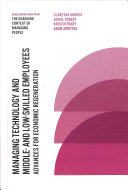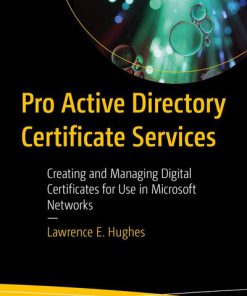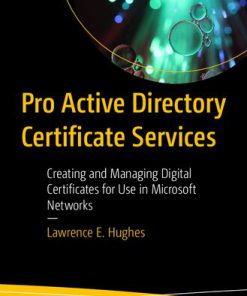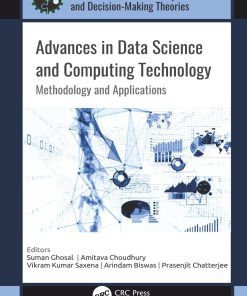Managing Technology and Middle and Low skilled Employees 1st Edition by Claretha Hughes, Lionel Robert, Kristin Frady, Adam Arroyos ISBN 9781789730784 1789730783
$50.00 Original price was: $50.00.$25.00Current price is: $25.00.
Managing Technology and Middle and Low skilled Employees 1st Edition by Claretha Hughes, Lionel Robert, Kristin Frady, Adam Arroyos – Ebook PDF Instant Download/Delivery: 9781789730784 ,1789730783
Full download Managing Technology and Middle and Low skilled Employees 1st Edition after payment

Product details:
ISBN 10: 1789730783
ISBN 13: 9781789730784
Author: Claretha Hughes, Lionel Robert, Kristin Frady, Adam Arroyos
Managing Technology and Middle and Low skilled Employees 1st Edition Table of contents:
Chapter 1 Introduction
Middle- and Low-skilled Workers and Technology Development
Wage Inequality and Low-skill Workers
Technology Disruption of Traditional Work
The Differences between Education and Training
Machine Learning
Conclusion
Chapter 2 Middle-skill-level Employees and Technological Environments
Introduction
The Middle-skill Workforce
Middle-skill Challenges
Challenges Facing Middle-skill Employers
Rapid Advances in Technology
The Skills Gap and Competition for Labor
Changing Labor Force / Workforce Demographics
Integrating Technology and Middle-skill Workers
Managing and Developing Teams across Disciplines
Developing Partnerships to Support Middle-skill Workforce Development
Developing a Recruitment Infrastructure
Building a Career Infrastructure for Workers
Career Pathways
Career Competency Models
Education, Upskilling, and Training
Conclusion
Chapter Case Study Example
Chapter 3 Virtual Teams and Technological Environments
Introduction
Types of Virtual Teams
Traditional or Organizational Virtual Teams
New Ways of Organizing Virtual Teams
Crowdsourcing Virtual Teams
Peer Production Online Communities
Geographic Dispersion
Temporal Dispersion
Communication Technologies
Types of Synchronous Appropriation
Types of Asynchronous Appropriation
POLC and Virtual Teams
Establish a Shared Vision, Mission or Purpose, and Values
Define the Team’s Goals and Objectives
Generate a Work and Resource Plan
Generate a Schedule
Generate a Plan of Action
Challenges to Planning in Virtual Teams
Solutions to Challenges to Planning in Virtual Teams
Organizing in Virtual Teams
Team Structuring
Team Coordination
Challenges to Organizing in Virtual Teams
Aligning the Organizing with Planning
Structuring and Coordinating Virtual Teams
Solutions to Challenges of Organizing Virtual Teams
Aligning the Organizing with Planning
Structuring and Coordinating Virtual Teams
Leading and Relationship Building in Virtual Teams
Traditional Leadership in Virtual Teams
Relationship Building
Trust
Obligations
Identity
Challenges to Leading Virtual Teams
Solutions to Challenges Leading, and Relationship Building in Virtual Teams
Shared Leadership in Virtual Teams
Relationship Building
Controlling in Virtual Teams
Types of Controls
Challenges to Controlling in Virtual Teams
Behavior versus Output Controls
Solutions to Challenges to Controlling in Virtual Teams
Conclusion
Chapter Case Study Example
Chapter 4 A Hiring Paradigm Shift through the Use of Technology in the Workplace
Introduction
Composition of the Workforce
Trends, Benefits, and Challenges of an Older Workforce
Integration of Technology in the Workforce
Strategies for Meaningful Inclusion of the Aging Workforce
Learning and Development
Knowledge Transfer
Career Pathway Development
Organizational Readiness to Implement Changes
Managing the Aging Workforce
Conclusion
Chapter Case Study Example
Chapter 5 Artificial Intelligence, Employee Engagement, Fairness, and Job Outcomes
Introduction
Employee Engagement
What Is Employee Engagement?
Motivation
Artificial Intelligence Employee Controls
Artificial Intelligence Behavior Control
Artificial Intelligence Outcome Control
Artificial Intelligence Trust and Perceived Risk
Artificial Intelligence Trust
Artificial Intelligence Perceived Risk
Artificial Intelligence Fairness
Artificial Intelligence Procedural Fairness
Artificial Intelligence Distributive Fairness
Artificial Intelligence Interactional Fairness
Artificial Intelligence Technology Characteristics
Artificial Intelligence Perceived Ease of Use
Artificial Intelligence Perceived Usefulness
Artificial Intelligence, Job Satisfaction, Job Meaningfulness, and Retention
Conclusion
Chapter 6 Designing and Managing Technology, Innovation Training, and Development for Middle-skill,
Introduction
Educational Technology Learning Principles, Factors, and Delivery Methods
Global Challenge Training Solutions
Disadvantaged Worker Characterization
Challenges to Developing Workers Using Technology
Creating an Agile Workforce
Education and Skills Deficiency
Need for Expanded Partnership between HRD and Workforce Development
Increased Human Productivity through Cognitive Development
Designing Training for Human–Machine Collaboration and Teams
Conclusion
Chapter 7 Managing People and Technology in the Workplace
Introduction
Managing People with Big Data
Flexible and Adaptive Leadership
Technology Adoption
Technology Development
Valuing People and Technology
Conclusion
Chapter Case Study Example
Chapter 8 Emerging Technologies and Trends
Introduction
Artificial Intelligence (AI)
Virtual Teams
Employee Experience (EX)
The Missing Middle
Emerging Trends
Conclusion
Chapter Case Study Example
References
Index
People also search for Managing Technology and Middle and Low skilled Employees 1st Edition:
managing technology advances
managing director technology
tech middle management
a middle manager has traditionally acted as an
a middle manager
Tags: Claretha Hughes, Lionel Robert, Kristin Frady, Adam Arroyos, Managing Technology, Low skilled Employees
You may also like…
Computers - Enterprise Computing Systems
Biology and other natural sciences - Genetics
Computers - Microsoft Windows
Uncategorized
Uncategorized
Computers
Advances in Data Science and Computing Technology by Suman Ghosal 9781000565430 1000565432
Business & Economics - Responsibility and Business Ethics











